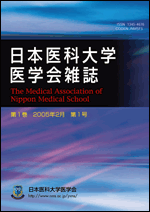Volume 18, Issue 2
Displaying 1-21 of 21 articles from this issue
- |<
- <
- 1
- >
- >|
-
2022Volume 18Issue 2 Pages 120
Published: April 25, 2022
Released on J-STAGE: May 12, 2022
Download PDF (150K) -
2022Volume 18Issue 2 Pages 121-124
Published: April 25, 2022
Released on J-STAGE: May 12, 2022
Download PDF (266K) -
2022Volume 18Issue 2 Pages 125-128
Published: April 25, 2022
Released on J-STAGE: May 12, 2022
Download PDF (903K) -
2022Volume 18Issue 2 Pages 129-134
Published: April 25, 2022
Released on J-STAGE: May 12, 2022
Download PDF (2512K) -
2022Volume 18Issue 2 Pages 135-137
Published: April 25, 2022
Released on J-STAGE: May 12, 2022
Download PDF (274K) -
2022Volume 18Issue 2 Pages 138-141
Published: April 25, 2022
Released on J-STAGE: May 12, 2022
Download PDF (256K) -
2022Volume 18Issue 2 Pages 142-145
Published: April 25, 2022
Released on J-STAGE: May 12, 2022
Download PDF (361K) -
2022Volume 18Issue 2 Pages 146-149
Published: April 25, 2022
Released on J-STAGE: May 12, 2022
Download PDF (361K)
-
2022Volume 18Issue 2 Pages 151
Published: April 25, 2022
Released on J-STAGE: May 12, 2022
Download PDF (266K)
-
2022Volume 18Issue 2 Pages 152-159
Published: April 25, 2022
Released on J-STAGE: May 12, 2022
Download PDF (352K) -
2022Volume 18Issue 2 Pages 160-167
Published: April 25, 2022
Released on J-STAGE: May 12, 2022
Download PDF (381K) -
2022Volume 18Issue 2 Pages 168-176
Published: April 25, 2022
Released on J-STAGE: May 12, 2022
Download PDF (354K) -
2022Volume 18Issue 2 Pages 177-184
Published: April 25, 2022
Released on J-STAGE: May 12, 2022
Download PDF (330K) -
2022Volume 18Issue 2 Pages 185-191
Published: April 25, 2022
Released on J-STAGE: May 12, 2022
Download PDF (364K)
Photogravure
-
2022Volume 18Issue 2 Pages 192-193
Published: April 25, 2022
Released on J-STAGE: May 12, 2022
Download PDF (441K)
Review
-
2022Volume 18Issue 2 Pages 194-201
Published: April 25, 2022
Released on J-STAGE: May 12, 2022
Download PDF (670K)
Article
-
2022Volume 18Issue 2 Pages 202-211
Published: April 25, 2022
Released on J-STAGE: May 12, 2022
Download PDF (597K)
Case Report
-
2022Volume 18Issue 2 Pages 212-215
Published: April 25, 2022
Released on J-STAGE: May 12, 2022
Download PDF (391K)
Talking Point
-
2022Volume 18Issue 2 Pages 216-217
Published: April 25, 2022
Released on J-STAGE: May 12, 2022
Download PDF (174K)
-
2022Volume 18Issue 2 Pages 218-219
Published: April 25, 2022
Released on J-STAGE: May 12, 2022
Download PDF (320K)
-
2022Volume 18Issue 2 Pages 220-222
Published: April 25, 2022
Released on J-STAGE: May 12, 2022
Download PDF (286K)
- |<
- <
- 1
- >
- >|
